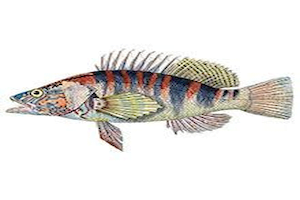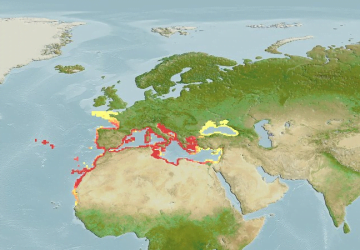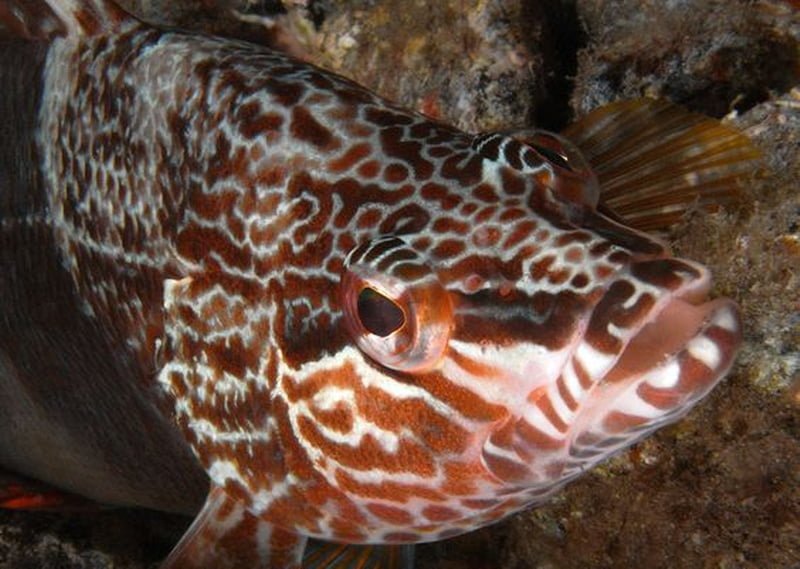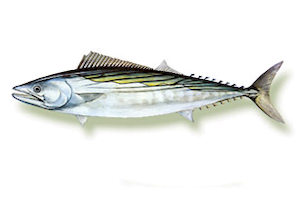Serranus scriba
– Painted Comber –

| Conservation status |
|---|
 Least Concern (IUCN 3.1)[1] |
| Scientific classification |
Serranus scriba
(Linnaeus, 1758)
| Kingdom: | Animalia |
| Phylum: | Chordata |
| Class: | Actinopterygii |
| Order: | Perciformes |
| Family: | Serranidae |
| Subfamily: | Serraninae |
| Genus: | Serranus |
| Species: | S. scriba |


The painted comber (Serranus scriba) is a species of marine ray-finned fish, a sea bass from the subfamily Serraninae, classified as part of the family Serranidae which includes the groupers and anthias. It is found in the eastern Atlantic Ocean, the Mediterranean Sea, and the Black Sea. Confusingly, a synonym of this species is Perca marina, but that name (as Sebastes marinus) has incorrectly been used for a separate species, the rose fish.
Description
The painted comber has a laterally compressed,[3] elongate body, although a little pot-bellied, and flattened laterally, with 68 to 73 scales on the lateral line. Its snout is pointed, with a straight profile, and its mouth widely slit , with fine sharp teeth.. The dorsal fin has 10 spines and 4-16 soft rays and the anal fin has 3 spines and 7-8 soft rays. The caudal fin is truncate.[4] It has a very large mouth for its size, which has many sharp teeth,[5] and is protractile.[6] The overall colour may be grey, purplish or reddish with 5-7 dark brown bars on the flanks> The head is marked with many narrow, wavy blue lines and red blotches. The dorsal, anal and caudal fins are marked with red dots.[4] There is a diffuse, purplish-blue blotch in the middle of the body.[6] The pelvic and pectoral fins are normally uniform pale yellow.[5]
The blue , even opalescent, stain that adorns her belly as well as the blue and red designs, evoking Arabic calligraphy, on the head and around the lids, are very specific. Finally, the caudal and the caudal peduncle * are yellow.Its dress is very characteristic: it has 5 to 7 dark vertical stripes , sometimes split downwards, on the sides.
The maximum recorded fish measurement is 36 centimetres (14 in), although 25 centimetres (9.8 in) is more typical>[2]
Distribution
The painted comber is found in the eastern Atlantic Ocean where its core range extends from the Straits of Gibraltar to Senegal, including the Canary Islands but it occurs as far north as the Bay of Biscay. Its range extends into the Mediterranean and Black Seas.[1]
Habitat and Biology
Biotope
This species is found at moderate depths (0 to 30 meters), mainly on rocky bottoms or grass beds. It is solitary, territorial and it will defend this territory against its congeners. Curious, she will come to see the diver.
The painted comber occurs over rocky bottom and among beds of Posidonia at depths of 5 to 150 metres (16 to 492 ft).[2] It normally speneds the day sheltering in rocky caves and is normally either solitary or found in small groups. It emerges at dusk to hunt.[5] It is a carnivorous species which is a territorial ambush hunter and has a diet made up of cephalopods, bivalves, crustaceans, fishes, and worms.[6] It is often used to indicate sites occupied by octopuses as it waits at the entrance scavenging the octopus’s discarded parts of shellfish.[5] The spawning season runs from late spring to early summer with the eggs being laid under stones near the shore.[3] It is a synchronous hermaphrodite, i.e. each individual has both male and female gonads and may be capable of self-fertilisation. They have a maximum life expectancy of 16 years.[6]
Drawing of a “Lettered Serramus” from The natural history of fishes of the perch family – The Naturalist’s Library, 1835
Alimentation
The serran script hunts on the lookout, close to the surface, hidden among algae or posidonia. It feeds on small fish, crustaceans and molluscs, and can pounce on its prey at lightning speed.
Reproduction
It takes place from April to September: we can then see the two breeders going up in open water. The sexual display then consists of shaping the belly towards the partner.
The eggs laid (up to 100,000) are glued to the stones.
The serran script is a synchronous hermaphrodite *, namely that all individuals are both male and female, endowed with a mixed genital organ, called “ovotestis” *. The same individual can therefore act successively as a male, then as a female with another partner. It is therefore not excluded that it is capable of self-fertilization.
Similar Species
Serran goat ( Serranus cabrilla ): although it is frequently read, it nevertheless seems difficult to confuse these two species, the kingfish being generally smaller and possessing a brick red dress, with generalized bands.
Parasites
The painted comber, like most fishes, is host to a variety ofinternal and external parasites and these include the copepods Lernanthropus scribae, Caligus scribae and Anchistrotos laqueus; an isopod Gnathia sp.; a monogean Protolamellodiscus serranelli; and two species of digeneans Helicometra fasciata and Lecithochirium musculus.[7]
Taxonomy
The painted comber was first formally described by Linnaeus in the 10th Edition of his Systema Naturae published in 1758 as Perca scriba.[8]
Human use
The painted comber is landed by artisanal fisheries using hook and line and trawls.[1] It is said to have palatable flesh and can be prepared using a variety of cooking methods.[9]
Associated Life
Like other fish, the wrasse can be parasitized by an anilocre ( Anilocra sp. ). It is a crustacean, isopod, which parasitizes the fish by attaching itself to its body thanks to powerful hooks which terminate its legs. It feeds on the blood of fish while causing local skin necrosis to varying degrees.
serran writing is a loyal customer of cleaning stations for the cleaning wrasse ( Centrolabrus melanocercus or black tail wrasse). With a little patience (stay at least 5 minutes near a cleaning station, with a minimum of bubbles and movements), we can see it requesting the cleaning, in an upright position, head up and mouth wide open.
Various Biology
This species is very common, even in the first few meters.
If his drawings are preserved, his colors, often cited as references, change radically at night.
The serran script regularly takes the pose of the Serranidae family, remaining motionless, camped on its tail, to fix the diver.
It throws itself voraciously on the baits and is easily angled. It is edible.
Further Information
In Italy, underwater hunters say that where there is a Serranus Scriba , an octopus hole is not far away.
In France, in spearfishing, there is no regulated minimum catch size for this species.
In Cerbère, long-time divers find that, if 15 years ago, the scriptwort was rarely encountered while diving, today it has become very common.






















































































































































































































































